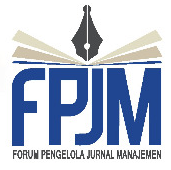Model Bisnis Triple Bottom Line Pasar Komunitas Makanan Sehat dan Pengembangannya dalam Mewujudkan Rantai Pasok Pangan Berkelanjutan
Abstract
The purpose of this study is to map explicitly about the triple bottom line business model that has been practiced by three healthy food community markets in Yogyakarta, namely Pasar Kamisan, Pasar Moncer, and Pasar Mustokoweni. The research method uses a qualitative method, especially with a multi-sites approach, where data obtained from the process of observation and in-depth interviews with stakeholders. Data analysis uses combination of business model canvas approach and SPOT matrix analysis. The study reveals that the community market needs to innovate performance on the nine blocks of their triple bottom line business model in terms of improving the quality of organizational performance and playing an optimal role in realizing a sustainable food supply chain.
https://doi.org/10.26905/jmdk.v7i2.3301
Keywords
Full Text:
PDFReferences
Ati, L., Baga, L. M., & Satria, A. (2019). Business Model Canvas Non Government Organization (Case Study: Rimbawan Muda Indonesia). Indonesian Journal of Business and Entrepreneurship (IJBE), 5(1).
Bash, K., & Donnelly, A. (2019). Sustainable Food Systems for a Healthier UK: A discussion paper.
Breuer, H., Fichter, K., Lüdeke-Freund, F., & Tiemann, I. (2018). Sustainability-oriented Business Model Development: Principles, Criteria, and Tools. International Journal of Entrepreneurial Venturing, 10(2), 256-286.
Calgary. (2012). Definition of a Sustainable Food System. Diakses pada July 14, 2019, dari https://www.calgary.ca/CA/cmo/Pages/Definition-of-a-Sustainable-Food-System.aspx
Casadesus-Masanell, R., & Ricart, J. E. (2010). From Strategy to Business Models and onto Tactics. Long Range Planning, 43(2-3), 195–215. doi:10.1016/j.lrp.2010.01.004
Cassell, C., Cunliffe, A. L., & Grandy, G. (2018). The SAGE Handbook of Qualitative Business and Management Research Methods. Los Angeles: SAGE Publications.
Downs, M. Ethan. (2017). The Local Food Movement: A More Sustainable Business Model. Retrieved June 11, 2019, from https://libres.uncg.edu/ir/asu/f/Downs, E_2017 Thesis.pdf.
Feldmann, C., & Hamm, U. (2015). Consumers’ Perceptions and Preferences for Local Food: A Review. Food Quality and Preference, 40, 152–164.doi:10.1016/j.foodqual.2014.09.014
Geissdoerfer, M., Savaget, P., & Evans, S. (2017). The Cambridge Business Model Innovation process. Procedia Manufacturing, 8, 262-269
Girotra, K., & Netessine, S. (2013). OM Forum—Business Model innovation for Sustainability. Manufacturing & Service Operations Management, 15(4), 537-544.
Grove. (2011). SPOT Matrix Leaders’ Guide. San Fransisco: The Grove Consultants International. ISBN 1–879502–30–5.
Gruchmann, T., Böhm, M., Krumme, K., Funcke, S., Hauser, S., & Melkonyan, A. (2019). Local and Sustainable Food Businesses: Assessing the Role of Supply Chain Coordination. Innovative Logistics Services and Sustainable Lifestyles, 143–163. doi:10.1007/978-3-319-98467-4_7
Halweil, B. (2004) Eat Here: Reclaiming Homegrown Pleasures in a Global Supermarket, 237 pp. London: W. W. Norton & Company Ltd. ISBN 0-393-32664-0.
Johnson, M., Christensen, C., Kagermann, H., (2008). Reinventing Your Business Model. Harvard Business Review. 86 (12), 50e59.
Jones, A. (2001). Eating oil. Food Supply in a Changing Climate, 89 pp. Berkshire, UK: Sustain and Elm Farm Research Centre.
Joyce, A., & Paquin, R. L. (2016). The Triple Layered Business Model Canvas: A Tool to Design More Sustainable Business Models. Journal of Cleaner Production, 135, 1474–1486.doi:10.1016/j.jclepro.2016.06.067
Osterwalder, A., & Pigneur, Y. (2010). Business Model Generation: A Handbook for Visionaries, Game Changers, and Challengers. New Jersey: Alexander Osterwalder & Yves Pigneur.
Wibowo, A. S. (16 Mei 2019). Wawancara personal.
Prasetyo, S. D. (1 Juli 2019). Wawancara personal.
Pretty, J. N., Ball, A. S., Lang, T. & Morison, J. I. L. (2005). Farmcosts and Food Miles: an Assessment of the Full Cost of the UK Weekly Food Basket. Food Policy 30, 1–20. (doi:10.1016/j.foodpol.2005.02.001).
Pucihar, A., Lenart, G., Kljajić Borštnar, M., Vidmar, D., & Marolt, M. (2019). Drivers and Outcomes of Business Model Innovation—Micro, Small and Medium-Sized Enterprises Perspective. Sustainability, 11(2), 344.
Rahardjo, M. (2017). Studi Kasus dalam Penelitian Kualitatif: Konsep dan Prosedurnya.
Rahdari, A., Sepasi, S., & Moradi, M. (2016). Achieving Sustainability through Schumpeterian Social Entrepreneurship: The role of Social Enterprises. Journal of Cleaner Production, 137, 347-360.
Safitri, A. (17 Mei 2019). Wawancara Personal.
Smith, B. G. (2008). Developing Sustainable Food Supply Chains. Philosophical Transactions of the Royal Society B: Biological Sciences, 363(1492), 849–861.doi:10.1098/rstb.2007.2187
Stella, D. (2019). Optimized food supply chains to reduce food losses. Saving Food, 227–248. doi:10.1016/b978-0-12-815357-4.00008-0
Sustain. (2002). Sustainable food chains. Briefing paper 2. Public Sector Catering; Opportunities and Issues Relating Tosustainable Food Procurement, 9 pp. London, UK: Sustain.
Sustainable Food Laboratory. (2005). The purpose of the Sustainable Food Lab is to accelerate the movement ofsustainably produced food from niche to mainstream. Diakses pada: 7 Juli 2019, dari http://www.glifood.org/.
Teece, D. J. (2010). Business Models, Business Strategy and Innovation. Long Range Planning, 43(2-3), 172–194.doi:10.1016/j.lrp.2009.07.003
The Economist. (2018). Global Food Security Index 2018: Building Resilience in the face of rising food-Security Risks. Diakses pada Juli 2, 2019, dari https://foodsecurityindex.eiu.com/
Van Huy, L., Chi, M. T. T., Lobo, A., Nguyen, N., & Long, P. H. (2019). Effective Segmentation of Organic Food Consumers in Vietnam Using food-related lifestyles. Sustainability, 11(5), 1237.
Walle, A. H. (2015). Qualitative Research in Business: A Practical Overview. Newcastle Upon Tyne: Cambridge Scholars Publishing.
DOI: https://doi.org/10.26905/jmdk.v7i2.3301
Refbacks
- There are currently no refbacks.
Indexing by:
| | |
Index Copernicus International (ICI)
Tools:
In Collaboration with:
 |
Jurnal Manajemen dan Kewirausahaan Management Department Faculty of Economics University of Merdeka Malang MAILING ADDRESS
|





